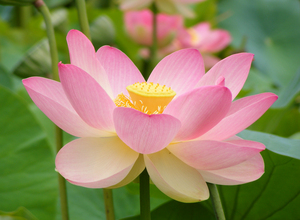Nelumbo nucifera, the Indian Lotus has captivated many people for thousands of years. It has symbolized beauty, grace and even divinity. Buddha and many of the Hindu gods are often depicted perched upon a lotus blossom. The lotus is also very important in Chinese and Japanese culture as well as many other countries in Asia. To gaze upon the elegant flowers, it’s no wonder that this plant has held such significance for so many people. Lotus are not actually difficult to grow and once established, will grow very vigorously. In fact, if not contained, a lotus can take over a pond. If you’re feeling adventurous, you might try growing this beautiful and exotic flower. Dwarf varieties can be grown in containers such as a half whiskey barrel on a sunny patio.
There are two species of lotus, as well as many hybrid varieties, the Indian lotus, Nelumbo nucifera as mentioned above and the American lotus, Nelumbo lutea. Before planting lotus, check to make sure it is not considered an invasive species in your area. There are too options for growing lotus: you can buy mature dormant tubers or seeds. Tubers will yield a mature plant in a shorter time than growing from seed but either way the plant will need some time to become established.
Dormant Tubers:
When you receive your tubers, unpack them very carefully making sure not to damage the growing tips. The tubers are usually white or yellowish and look somewhat like long skinny potatoes. (Potatoes, in fact, are also tubers.) The tubers will have one or multiple growing points that have a dark sheath and pointed tips. Lotus tubers are usually shipped mid to late winter while the plant is still dormant. As temperature and light levels increase the tuber will begin to grow fresh roots and foliage. Once you receive your lotus tuber, you can start it inside in a container of water near a bright window. Lotuses are sensitive to chlorine and if your tap water is heavily chlorinated don’t use it. Don’t allow the tuber to dry out and change the water if it becomes cloudy. You will quickly start to see roots and the growing tips will extend and start producing leaves. Once outside temperature is warmer and there is no danger of frost, you can plant your tuber in soil in a container and sink it into a pond or move it to an outside patio. Lotus plants love warm temperatures and lots of sun. During the hottest part of the summer growth can be very rapid and the leaves will increase to enormous sizes, depending on the species. During this time, the plant will require lots of nutrients and will need regularly fertilizer. Fertilizer tablets made for aquatic plants are best.
Seed:
Lotus seeds are large and have a thick, hard seed coat. To initiate germination, the seeds must scarified, which involves making a whole in the seed coat to allow water inside. Using sandpaper or a sharp file, scratch at the seed coat until the white interior just starts to become visible. Place the seeds in warm water and within hours the seeds will swell and sink to the bottom. Seeds that don’t become enlarged or don’t sink are probably no longer viable, but give them a few days before you decide to toss them. In sometimes as quickly as 24 hours, usually 3-5 days, green shoots will emerge from the seeds. Allow them to grow in a container until temperatures are appropriate outside for planting.
Winter Care:
As temperatures cool and the day gets shorter your lotus start to go dormant. New growth will cease and the leaves will gradually die. Resist the urge to cut off the dying leaves because they still supply oxygen to the tuber and cutting them off before the tuber is completely dormant might suffocate it. Lotus can tolerate cold temperatures as long as the tuber itself doesn’t freeze. If your lotus is in a large pond and this is not a problem simply leave the plant in the pond and it will return in spring. If you are worried about freezing and your lotus is in a container, you can move it into a garage or basement. Put a layer of mulch over the dormant plant to keep it moist but not completely submerged. Another option is to carefully dig up your tubers and store them in plastic bags in the refrigerator until spring. Make sure to open the bags every once in a while to allow air circulation. In spring, as temperatures increase, you can replant your tubers as detailed above.
With this information, some patience and care, you’re on your way to having your own lotus that will reward you with magnificent flowers.





